By going through these Maharashtra State Board 12th Science Biology Notes Chapter 10 Human Health and Diseases students can recall all the concepts quickly.
Maharashtra State Board 12th Biology Notes Chapter 10 Human Health and Diseases
Introduction-
- Health : World Health Organization (WHO) define health as ‘the state of complete physical, mental and social well-being and not merely the absence of disease or infirmity’.
- Health is metabolic and functional efficiency of living organisms.
- Hygiene : Science of rules of health.
- Important factors to achieve good health : Hygienic balanced diet, clean drinking water, personal and community hygiene, regular physical exercise, knowledge about diseases and their effect on body, proper disposal of wastes and control of vectors.
- Immune system : The ability to resist almost all types of these foreign bodies is possible due
to immune system. It protects human beings from various pathogens or infectious agents. - Resistance : The ability to prevent the damage or disease, through our defence mechanism.
![]()
Immunity-
1. Immunity: Immunity is the resistance exhibited by the host towards infections caused by pathogens and their products.
2. Immunology: Study of immune system, immune responses to foreign substances and their role in resisting infection by pathogens.
3. Edward Jenner : Started the concept of immunity. Cowpox vaccine was developed by him.
4. Antigen : Any foreign substance invading body and capable of stimulating an immune response.
5. Antibody : The protective chemicals produced by immune cells in response to antigens are called antibodies.
6. Types of immunity-
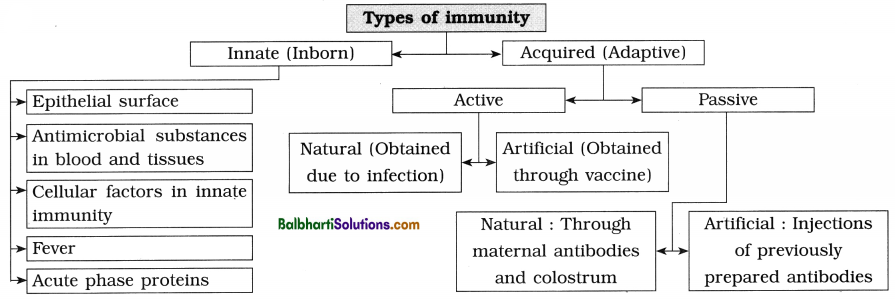
7. Innate immunity :
- Inborn immunity which is non-specific and not affected by immunization.
- The barriers of innate imunity are as follows:
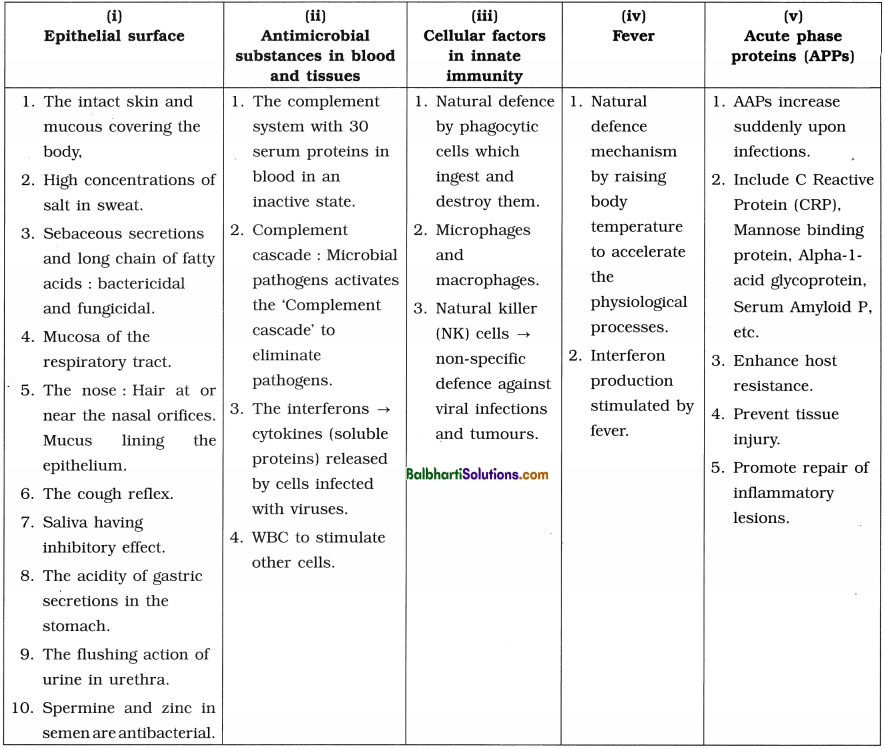
8. Acquired immunity :
(1) Specific or adaptive immunity acquired during lifetime due to infections.
(2) It involves formation of antibodies from the destruction of foreign antigens.
(3) Unique features of acquired immunity are specificity, diversity, discrimination between self and non-
self and memory.
(4) Types of acquired immunity :

![]()
9. Cells of immune system :
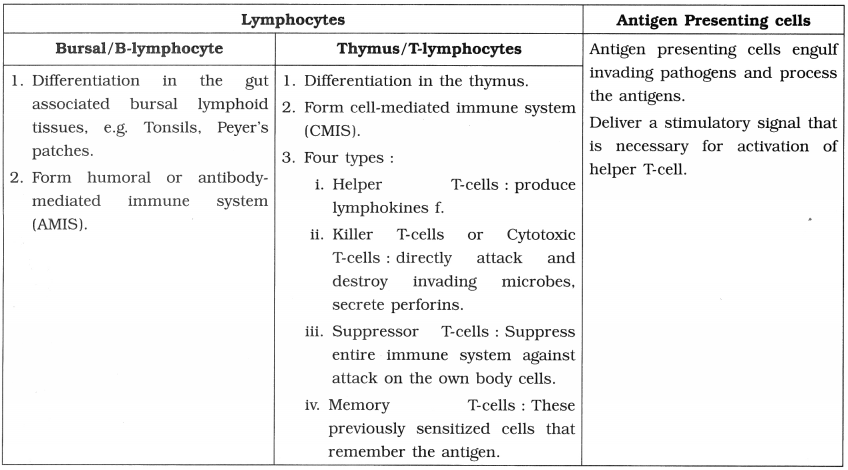
10. Mechanism of action of B-lymphocytes to antigens :
B-lymphocytes → sensitized directly by antigens and helper T-cells.
Activated B-lymphocyte → multiplies rapidly → Clone of plasma cells and memory B-cells produced → Plasma cells produce → Glycoproteins, called antibodies → Antibodies circulated through humor/ body fluids like blood and lymph → The antibody → bind to a cell membrane or they remain free.
11. Three main functions of free antibodies :
| Agglutination | Opsonisation | Neutralization |
| Immobilization of foreign particles in mass and then engulfing them by phagocytes. | Coating the bacteria to facilitate the phagocytosis by macrophages. | Neutralizing toxins released by bacteria. |
12. Vaccination :
- Vaccination : Administration of inactivated pathogen or antigenic protection of particular pathogen for protecting against a particular pathogen, is called vaccination.
- Vaccine : Inactivated pathogen or antigens of a specific disease.
- Vaccination is a primary prevention as it helps the body to recognize and eliminate pathogenic organism.
- Disease control on mass scale is done through vaccination. E.g. Measles, polio, tetanus and whooping cough, tuberculosis, etc. are prevented through vaccination.
Structure of antibody-
1. Antibodies are highly specific glycoproteins which can neutralize specific antigens.
2. Chemically they are Immunoglobulins (Igs), produced after antigenic stimulation.
3. Production in plasma cells which are formed by B-lymphocytes.
4. Rate of production of antibodies is very rapid, i.e. about 2000 molecules/second.
5. Structure of antibody :
- ‘Y’-shaped molecule. Having four polypeptide chains : Two heavy or H-chains and two light or L-chains.
- Y-structure formed from four polypeplidc chains are held together by disulfide bonds (-s-s-).
- Hinge : This is region holding together arms and stem of antibody.
- Two distinct regions : Variable region and the constant region.
- Paratope : This is antigen binding site present in variable region.
- Epitope : Antigen has antigenic determinant site, called epitope.
- Bivalent antibodies : Antibodies having two antigen binding sites.
- Serology: Study of antigen-antibody interactions.
- FormatIon of antigen-antibody complex: Epitopes (On antigens) and paratopes (on antibody) react with each other. Each antibody Is specific for specific antigen due to variable regions having small variations. Specific antibody binds to specific antigen forming an antigen-antibody complex.
- Antigen on Blood Cells: Antigens (A, B, D) on the surface of human red blood cells : responsible for different blood groups.
- Blood group systems : ABO, Rh. Duffy, Kidd. Lewis, R MNS, Bombay blood group. etc.
(12) ABO Blood Groups:
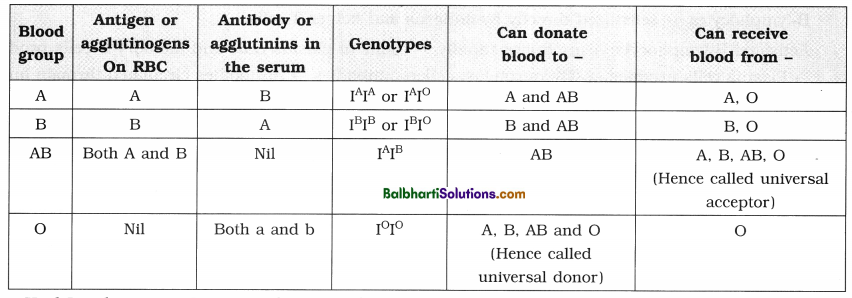
(13) Rh factor :
- Landsteiner and Wiener (1940) discovered Rh factor or D antigen on the surface of RBCs of Rhesus monkey. Hence called Rh factor.
- Rh positive (Rh+ve) person has D antigen. Rh negative person lacks it.
- Rh (D) antigen induces a strong immunogenic response when introduced into Rh-ve individuals.
- Haemolytic diseases of the newborn (HDN), or erythroblastosis foetalis occurs when an Rh —ve mother conceives Rh + ve foetus.
Common Human Diseases-
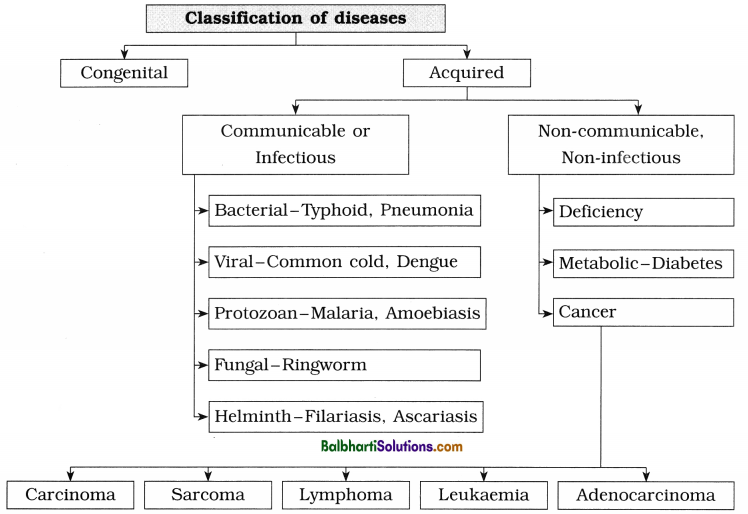
10. Cancer : Cancer is caused due to abnormal, uncontrolled and purposeless division of cells which may form tumour.
(1) Neoplasm : Masses of tissue which form lumps due to uncontrolled cell division.
(2) Oncologists : Oncologists are the physicians and researchers who specialize in the study, diagnosis, treatment and prevention of cancer.
(3) Tumour is mass of undifferentiated cells.
(4) Two types of tumours :
Benign / Non-malignant Tumour:
- Slow growth and Larger size
- Does not spread to other body parts.
- Usually harmless.
- But may sometimes become malignant.
e.g. Adenoma and Fibroid. - Brain tumour can be fatal, though it is benign.
Malignant tumour or cancer”
- Rapid growth and not much bIgger.
- Spreads to other body parts. via blood or lymph. (The process of metastasis)
- Usually harmful.
- Overcrowding and disruption of normal cells.
![]()
(5) Types of Cancer : Five main types according to tissue on which they thrive.
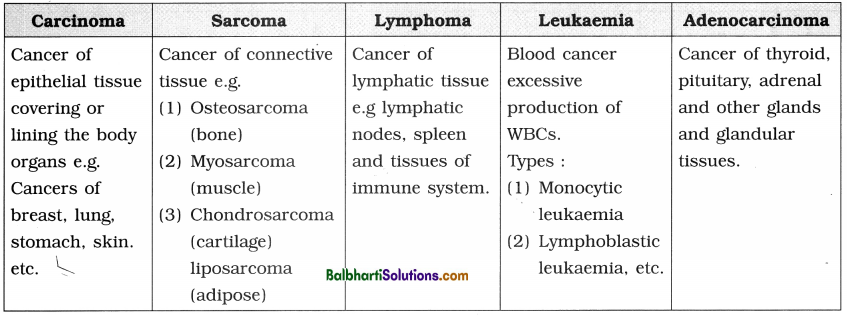
(6) Causes of Cancer : Also called carcinogenic factors.

(7) Treatment of Cancer :
- Chemotherapy
- Radiotherapy
- Surgery
- Immunotherapy
- Supportive therapy
11. AIDS :
(1) AIDS : Acquired immuno deficiency syndrome, fatal and incurable illness caused by a retrovirus (ss RNA) called HIV (Human immunodeficiency virus).
Body’s immune system is weakened increasing vulnerability causing many life-threatening opportunistic infections, neurological disorders and malignancies.
(2) Structure of HIV :
- Spherical, 100 to 140 nm in diameter, with centrally located two ss RNA molecules and reverse transcriptase enzymes.
- Covering of two layers of proteins.
- The outer layer is of matrix protein (pi7) with additional layer of lipid.
- Impregnated with glycoprotein GP120 and GP 41.
- Inner layer is capsid protein (p24)
- Replication of HIV in dividing T4 lymphocytes. They remain in latent state in lymphoid cells.
(3) Blood, semen and cerebrospinal fluid (CSF) show maximum concentration of HIV in infected person. Lesser extent seen in tears, milk, urine, saliva, cervical and vaginal secretions.
(4) Transmission of virus :
- Unsafe sexual contact : Oral, vaginal and anal sex.
- Blood : Blood transfusions or sharing syringes, needles, etc.
- Transplacental (From mother to child during pregnancy via placenta) and by nursing mother through breast milk.
- Accidental needle injury, artificial insemination with infected semen and transplantation with infected organs.
- Through urine, tears, saliva, breast milk and vaginal secretions if these secretions enter passes in the body through injury.
(5) Clinical manifestations : Four broad categories.
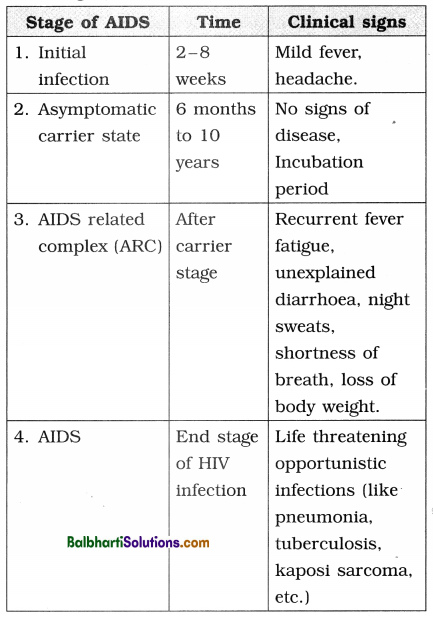
(6) Preventive measures :
- Prevention is the only measure as there is no cure for AIDS.
- Education of highrisk group, about HIV transmission.
- Disposable needles and syringes.
- Sexual habits to be modified.
- No sharing of toothbrushes, razors, etc.
- Blood to be screened before receiving.
Routine screening must for –
- Blood donors.
- Organ donors (kidney, liver, lung, cornea).
- Donors of semen and growth hormone.
- Patients undergoing haemodialysis.
- Pregnant females in highrisk group.
(7) Laboratory diagnosis :
- ELISA (Enzyme-Linked Immunosorbent Assay) : This test is for detection of AIDS.
- Western Blot : Second and confirmatory test which detects specific antibody to viral core protein and envelope glycoprotein.
(8) Treatment of AIDS : Antiretroviral therapy (ART) : Antiretroviral drugs for reducing viral load and prolong the life of HIV patient. E.g. TDF (tenofovir), EFV (Efavirenz), Lamivudine (3TC), etc.
Adolescence-
1. Adolescence Is transitional stage of physical and mental development during puberty and the legal adulthood. National youth policy defines phase of adolescence during 13—19 years. This period Is marked with sexual and reproductive maturity mental development, adalt Identity and transition from socioeconomic and emotional dependency to relative independence.
2. Stages of Adolescence :
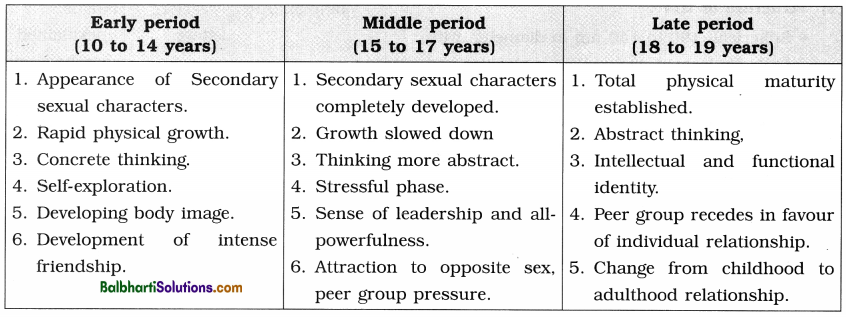
3. Physical changes of adolescence:
- Growth spurt.
- Sexual development
- Emotional and social changes
4. Mental Health and Adolescence:
- Confusion, irritation. moodiness, frustration, nausea, less concentration, hyper activities, anger. effects on lifestyles like obesity, addictions, accidents, leading to ill health. etc. are common problems in adolescent age.
- Psychoses or neuroses may appear.
- Psychoses include delusions, hallucinations. disturbance In the thinking process, etc.
- AmnesIa (loss of memory). Bullirnia (extreme over indulgence in food), Anxiety (fear or apprehension), Anorexia nervosa (emotional aversion to food) depression (sadness, inactivity reduced to enjoy life, etc.), illusions, hallucination, etc.
- Characterized by number of cognitive, emotional, behavioural, physical and attitudinal changes.
- Parental communication and other conditions mould the adult personality.
- Improper peer pressure may result into addictions, like smoking, taking drugs, etc.
5. Treatment: Treatment of such disorders should be done only through counselling and not medicines with due respect to rights of children. Mental health Gap Action Programme (mhGAP) gives the guidelines as per WHO for treating such cases. Parental relations are most important in any treatment.
![]()
Addiction –
1. Addiction : Compulsive use of substance despite its harmful consequences is addiction. Addiction cause the impairment of physical, physiological and psychological functions of the body.
2. Addictive substances : Alcohol, opioids, cocaine, nicotine and some behaviours such as gambling.
3. All addictive behaviours share key neurobiological features, involving brain pathways of reward and reinforcement.
4. Neurotransmitter dopamine released during motivation.
5. Neurological changes are reversible after the substance abuse or behaviour is discontinued.
6. Causes of substances abuse during adolescence :
- Parental neglect and insufficient parental supervision and monitoring.
- No communication between child and parents.
- Absence of poorly defined rules.
- Family conflicts.
- Favourable parental attitudes towards alcohol and drug uses.
- Risk taking behaviour.
7. Measures to control drug abuse :
- Always remember ‘Prevention is better than cure’.
- Children should not be pressurized. Over expectations from them should be avoided.
- Suitable education and counselling whenever required.
- Sublimation and channelization of the energy of child in sports, studies and other constructive activities.
Drugs Abuse-
1. Drugs and alcohol use in youth leads to many harmful effects. Improper lifestyle with dangerous behaviour pattern should not be accepted as it is hazardous for all.
2. The drugs of abuse are opioids, cannabinoids and alkaloids of coca and hallucinogens.

3. Addiction and Dependence :
- Inherent addictive nature of alcohol and drugs result into psychological attachment to certain effects-such as euphoria and a temporary feeling of well-being.
- Repeated use of drugs increases the tolerance level of the receptors present in our body.
- Person getting addicted, starts self-destructive behaviour.
- Withdrawal symptoms : If regular addictive substance is discontinued, it results in withdrawal symptoms. All the symptoms seen in such person is called withdrawal syndrome, which is characterized by anxiety, trembling, nausea and sweating.
![]()
4. Effects of Drug/Alcohol Abuse :
- Reckless behaviour, vandalism and violence.
- Excessive doses of drugs can cause coma and death due to respiratory failure, heart failure or cerebral haemorrhage.
- Overdose and even deaths occur if there is weird combination of drugs and alcohol.
5. Warning signs of drug and alcohol abuse among youth :
- Drop in academic performance.
- Unexplained absence from school/college.
- Lack of interest in personal hygiene, withdrawal, isolation, depression, fatigue, aggressive and rebellious behaviour, deteriorating relationships with family / friends.
- Loss of interest in hobbies.
- Change in sleeping and eating habits.
- Fluctuations in weight, appetite, etc.
- May turn to crime for money.
6. Other hazards : Intravenous injections of drugs can cause serious infections like HIV and hepatitis B.
7. Long-term effects : Loss of equilibrium, liver cirrhosis, pancreatitis. Damage to nervous system and liver (cirrhosis). Use of drugs and alcohol during pregnancy adversely affects the foetus.
8. Performance enhancers :
- Sportspersons use drugs to enhance performance.
- Narcotic analgesics, anabolic steroids, diuretics and certain hormones to increase muscle strength and bulk and to promote aggressiveness and overall improvement in their performance.
- Anabolic steroids have side effects :
(a) Effects in females : Masculinization in females, increased aggressiveness, mood swings, depression, abnormal menstrual
cycles, excessive hair growth on the face and body, enlargement of clitoris, deepening of voice.
(b) Effects in males : Acne, increased aggressiveness, mood swings, depression and reduction of size of the testicles, decreased sperm production, kidney and liver dysfunction, breast enlargement, premature baldness, enlargement of the prostate gland.
9. Prevention and Control : Habits such as smoking, taking drug or alcohol should be avoided right from young age. Identify the situations which can form addictions and take remedial measures. Help from parents and teachers should be sought.